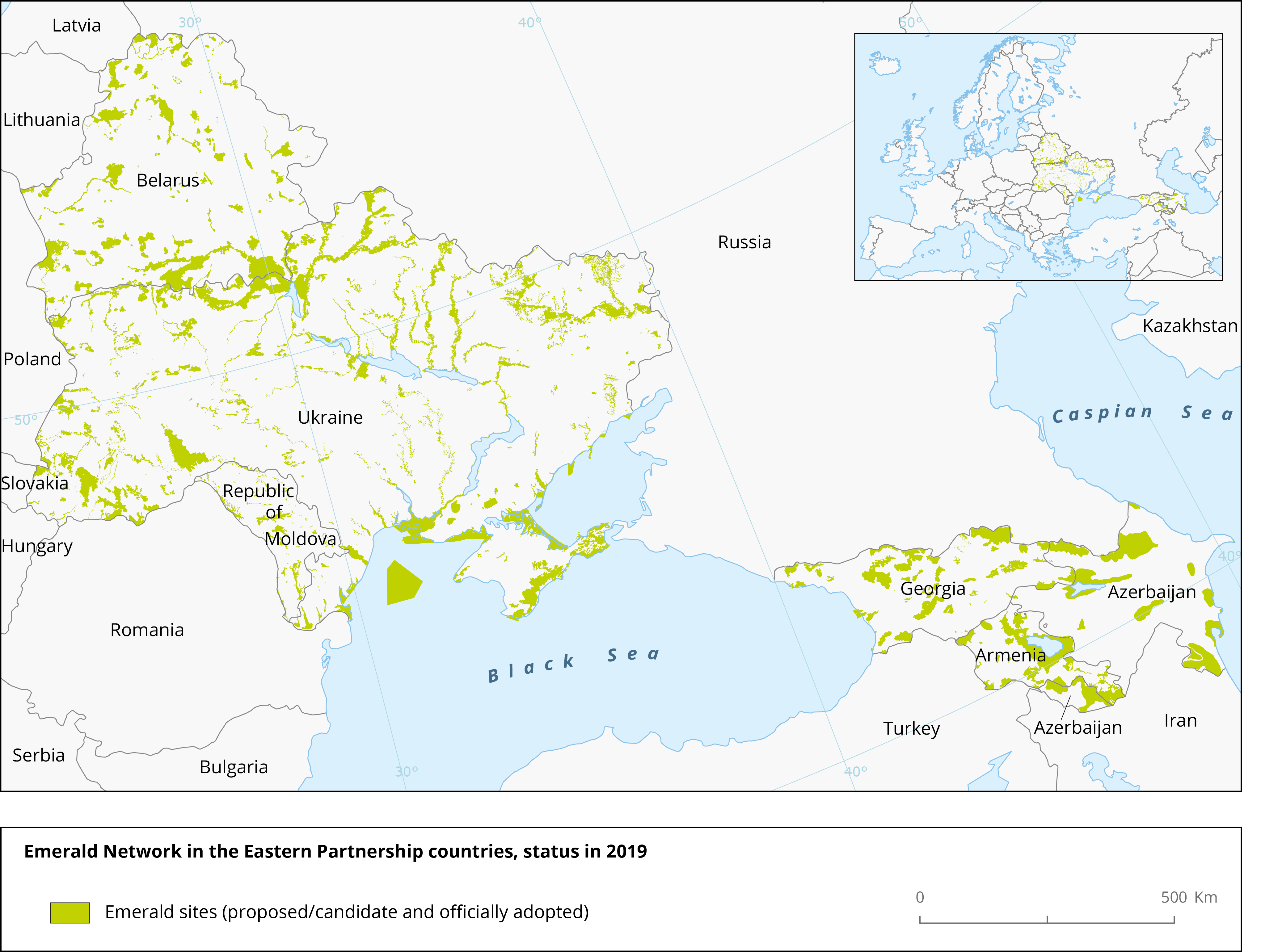
Note: All sites, both proposed and adopted, are included in the map.
Source: Country submissions to the Bern Convention via the EEA's Reportnet (accessed May 2020). Download map here.
During the informal ministerial dialogue between Eastern Partnership countries and the EU, held on 5 July 2015 in Minsk (Belarus), the ministers of environment for these countries underlined the need for further cooperation in areas of common interest and concern, and biodiversity in particular, to meet the Aichi Biodiversity Targets for the biodiversity strategy to 2020 (European Commission, 2015).
These countries are rich in biodiversity. The Caucasus region is widely recognised as being one of the global hot spots of biodiversity (BirdLife International, 2020; Caucasus Nature Fund, 2020; Myers et al., 2000). Three Eastern European countries, Belarus, Republic of Moldova and Ukraine, are home to important areas of wetland and forest habitats and related species (Frankfurt Zoological Society, 2020; TNC, 2020; BirdLife International, 2020).
Contribution to Aichi Biodiversity Target 11
Aichi Biodiversity Target 11 of the Convention on Biological Diversity is a global target. It requires: ‘by 2020, at least 17 % of terrestrial and inland water areas and 10 % of coastal and marine areas are conserved through effectively and equitably managed, ecologically representative and well-connected systems of protected areas and other effective area-based conservation measures, and integrated into the wider landscape and seascape’ (UNEP, 2011). Similarly, the United Nations Sustainable Development Goals 14 and 15 aim to ensure long-term protection of the terrestrial and marine biodiversity via the implementation of protected areas (United Nations, 2020).
Several Eastern Partnership countries have set national targets for protected area coverage to be reached by 2020 (Table 1). Over the last two decades (2000-2019), coverage of nationally protected areas increased by approximately 150 % in Republic of Moldova, doubled in Azerbaijan, and grew by 75 % in Ukraine, 37 % in Georgia, 26 % in Armenia and 17% in Belarus.
| Countries | Armenia | Azerbaijan | Belarus | Georgia | Republic of Moldova | Ukraine |
|---|
| Protected area coverage (%) in 2020 |
12.9 |
10.9 |
9.0 |
9.6 |
5.7 |
8.1 |
| National targets (%) |
Terrestrial |
NNA* |
NNA |
8.8 |
12 |
8 |
15 |
|
Marine |
NA* |
|
NA |
2.5 |
NA |
NNA |
*NNA: no national target set
**NA: not applicable
Note: Data coverage – Armenia (2000-2017); Azerbaijan (2000-2018); Belarus (2001-2019); Georgia (2011-2019) ; Republic of Moldova (2000-2018) and Ukraine (2000-2017).
Sources: (Council of Ministers Belarus, 2010; MENRP, 2014; Government of Republic of Moldova, 2015).
According to the evaluation of the Convention on the Biological Diversity (CBD, 2020) the Eastern Partnership countries have been making progress above the global average in integrating national protected area systems into the global network as their contribution to the globally agreed goals (Table 2). Similarly, the countries have also been making management of these areas more effective.
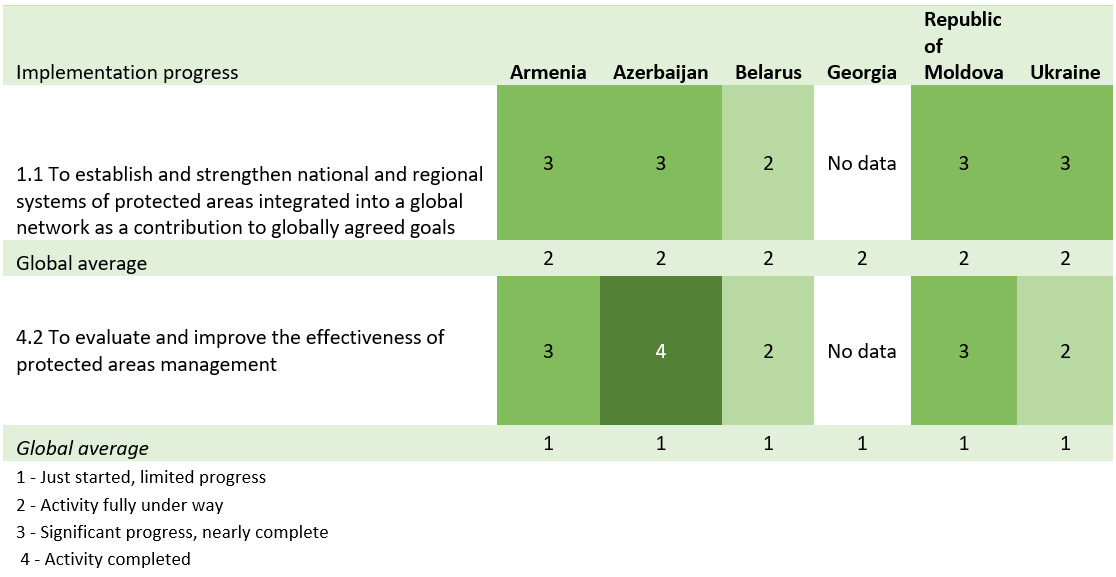
Source: (CBD, 2020).
Different approaches taken to protect nature in each country
The Eastern Partnership countries apply various types of protected area designations (EEA, 2020). Armenia applies 19 different protected area legislations or legal acts, while Republic of Moldova has 13, Ukraine has 11, Azerbaijan has 10 and Belarus has 7. This diversity in designation types and their related legal instruments reflects the heterogeneous way nature protection is being implemented at the national level. The International Union for Conservation of Nature (IUCN) tried to harmonise the assement of nature protection by designing a series of management categories (Dudley, 2013). However, since these IUCN management categories are interpreted and applied differently by each national administration (EEA, 2012a) it is not possible to group national designation types according to these categories in order to obtain a meaningful result. This heterogeneous approach to the use of IUCN management categories is shown in Figure 1. Without detailed legal analysis of the relevant legal instruments, it is impossible to compare the level of protection afforded to each designation.
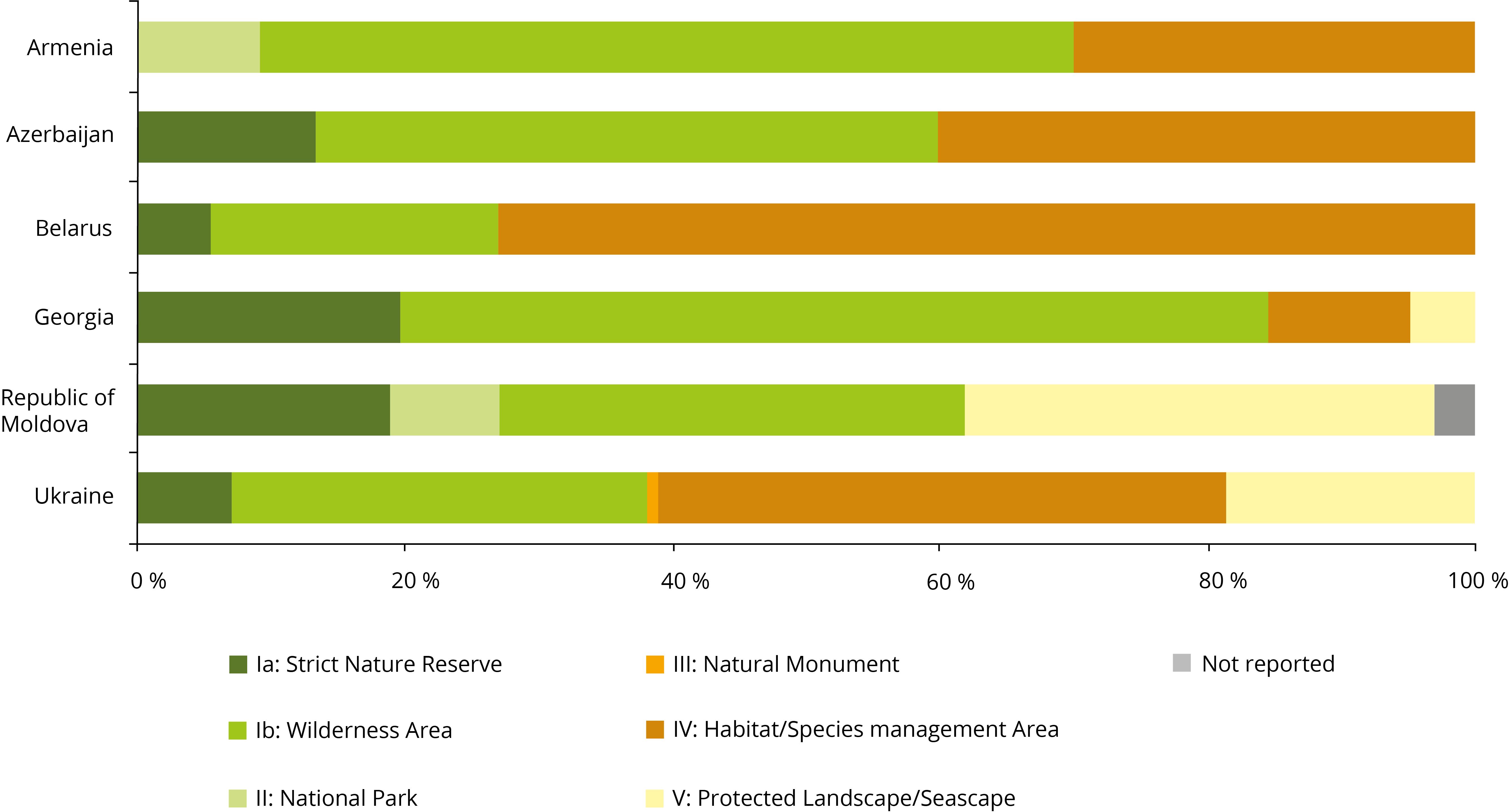
Data source: Data delivered by the countries in the ENI East II project.
It should also be noted that some of the protected areas mainly encompass a variety of landscapes and are dedicated primarily to protecting those landscapes rather than their biodiversity (EEA, 2012b).
Bern Convention’s Emerald Network expanded in the Eastern Partnership countries
The six Eastern Partnership countries are party to the Bern Convention. Under the Bern Convention, the Emerald Network represents the most important coordinated European network of protected areas after the EU’s Natura 2000 (European Commission, 2020b).
A crucial element of the Emerald Network designation process is the assessment of the network’s ability to support the species and habitat types targeted by the Bern Convention. This is done to ensure the best opportunities for the long-term survival of those species and habitats within the network of both adopted and proposed Emerald sites. The sufficiency process is done at the regional scale and extends across several countries, based on the biogeographical regions (Roekaerts and Opermanis, 2018). This approach is key to the international coordination of Emerald sites. A similar approach is used for the assessment of Natura 2000 sites, including all those both adopted and proposed by EU Member States.
Since 2009, the setting up of the Bern Convention’s Emerald Network in the Eastern Partnership countries has been supported by consecutive EU/Council of Europe programmes co-financed with the European Commission. This has resulted in the creation of 561 Emerald sites (at various stages of progress from proposed, to candidate to formally adopted), covering 12.3 % of the territories of the six countries (Halada et al., 2020).
Throughout the ENI SEIS II East project, the EEA provided expertise on sufficiency assessments of species and habitats in the countries proposed for inclusion in the Emerald Network. As a result of progress made during the period 2017-2019, in general, there has been significant growth in the number and area of coverage of Emerald sites in Eastern Partnership countries (Table 3). Coverage of the Emerald network has expanded in all countries except the Republic of Moldova. In Republic of Moldova, despite increasing the number of Emerald sites between 2016-2019, the total area has decreased by 3 %, mainly due to the greater precision of site-area data (Halada et al., 2020).
| Country | 2016 | 2019 |
|---|
|
No. of sites |
Emerald area |
% national coverage |
No. of sites |
Emerald area |
% national coverage |
| Armenia |
21 |
497 883 |
17 |
23 |
1 082 883 |
36 |
| Azerbaijan |
16 |
1 609 952 |
18 |
17 |
1 678 009 |
19 |
| Georgia |
54 |
1 025 579 |
14 |
58 |
1 286 043 |
18 |
| Belarus |
64 |
1 824 749 |
9 |
162 |
2 411 130 |
12 |
| Republic of Moldova |
26 |
373 679 |
11 |
61 |
271 780 |
8 |
| Ukraine |
169 |
4 680 470 |
8 |
377 |
6 882 300 |
11 |
The overlap between nationally protected areas and Emerald sites (candidate or formally adopted sites) illustrates the extent to which a country has made use of nationally protected areas to underpin its Emerald designation and how far these sites extend beyond, and probably complement, the existing protected areas network at the national level (Figure 2).
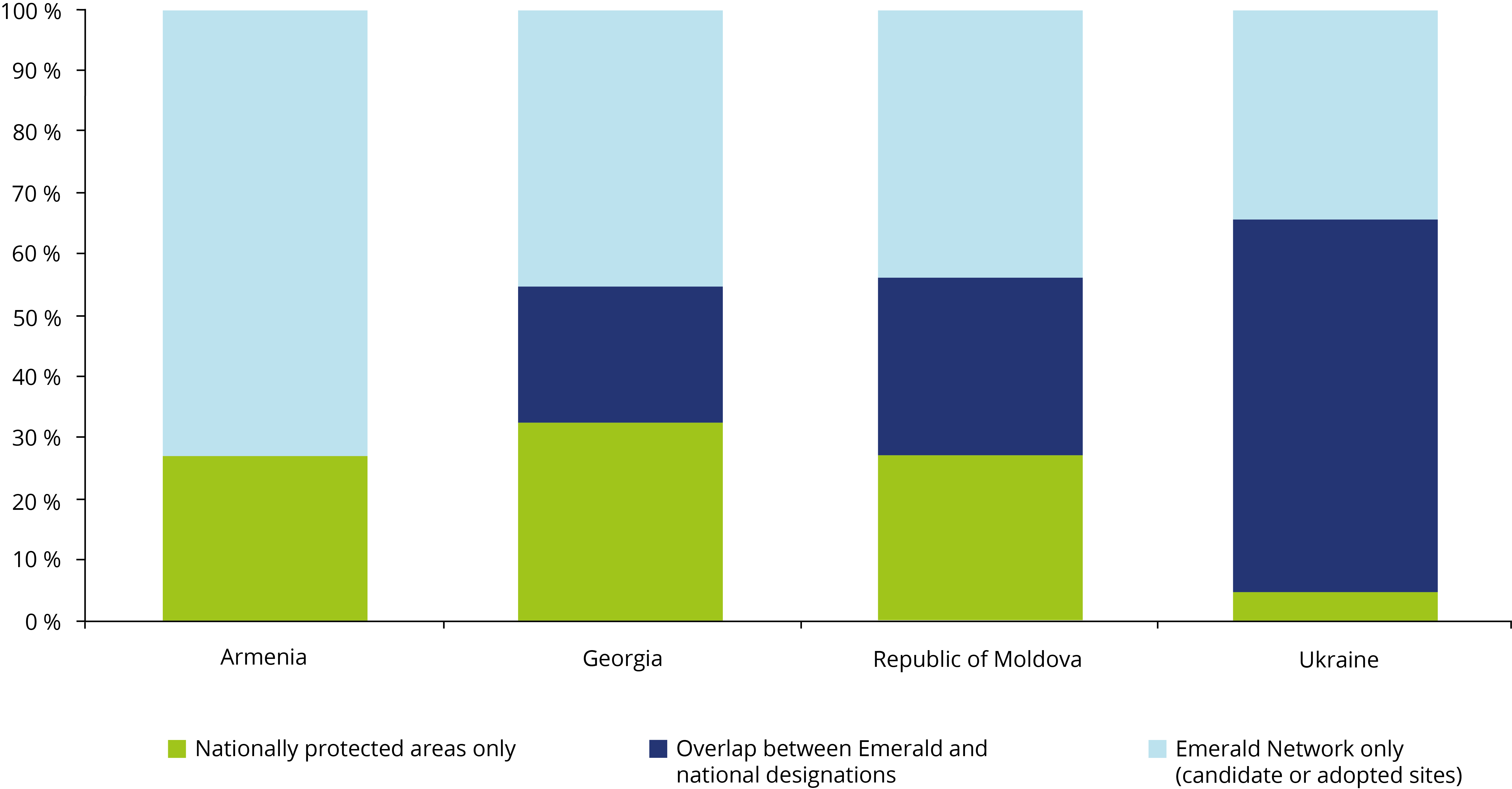
Data source: Marc Roekaerts and Otars Opermanis, 2018.
Armenia: (D1) Main indicators specially protected areas by categories and years provided by ArmStat – The Statistical Committee of the Republic of Armenia.
Data on Emerald sites provided by Armenia’s Ministry of Environment (formerly the Ministry of Nature Protection) under the ENI SEIS II East project activities.
Georgia: Protected areas database provided by the Agency of Protected Areas of Georgia, under the ENI SEIS II East project activities.
Republic of Moldova: Data on protected sites provided by the Biodiversity Office, Ministry of Agriculture, Regional Development and Environment of Republic of Moldova, under the ENI SEIS II East project activities.
Ukraine: Data provided by the Department of EcoNet and Protected Areas of the Ministry of Ecology and Natural Resources of Ukraine, under the ENI SEIS II East project activities.
Protected areas outlook
Eastern Partnership countries have made good progresses in implementing the Programme of Work on Protected Areas of the Convention on Biological Diversity. Nevertheless, preparatory discussions for negotiations on the post-2020 framework of global biodiversity policy[1] already indicate that more efforts would be needed in future when compared to Aichi Target 11. Improving the effectiveness of the management of protected areas as well as putting efficient monitoring programmes in place should be among the priorities for Eastern Partnership countries.
All Eastern Partnership countries have been making efforts to respond to international reporting obligations. Through the efforts of national governments, which have also been supported by international organisations, information on habitats, species and protected areas is being made increasingly available to the public (EEA, 2020c) while data is openly available from the EEA Reportnet (EEA, 2020a). Nevertheless, there is still a large gap between monitoring efforts, data harmonisation, and the use of available data for supporting the knowledge-based policy processes in Eastern Partnership countries.
Therefore, there is a continued need for countries to further strengthen their monitoring programmes on habitats and species while improving the capacity of those experts who provide data and information for knowledge-based policy processes.
Eastern Partnership and EEA contributions
The Eastern Partnership (EaP) is a joint policy initiative which aims to deepen and strengthen relations between the EU, its Member States and its six Eastern neighbours: Armenia, Azerbaijan, Belarus, Georgia, Republic of Moldova and Ukraine (European Commission, 2020a).
Under the EaP joint policy initiative, a four-year project on ‘Implementation of the Shared Environmental Information System (SEIS) principles and practices in the ENP East region’ (the ENI East II project, 2015-2019) (EEA, 2020b), was granted by the EU to promote the principles of a Shared Environmental Information System and its impact on better environmental governance in various thematic areas, including biodiversity conservation (European Commission, 2016).
Throughout the project, the European Environment Agency (EEA) supported capacity building in the Eastern Partnership countries for improved reporting under international obligations, such as the Bern Convention, and indicator development for knowledge-based policymaking (EEA, 2020c).
This briefing is an extract from the indicator on protected areas (D1 – UNECE environmental indicator) developed for each Eastern Partnership country under the ENI SEIS II East project. The indicator has been developed according to the template of the EEA Streamlined European Biodiversity Indicator 007 – Nationally designated protected areas (EEA, 2019), which explores both nationally and internationally designated protected areas, such as the Emerald Network, and their geographical overlap.
This briefing is also available in
Russian
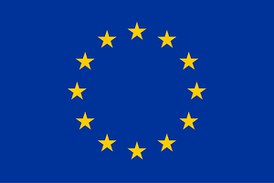



Document Actions
Share with others